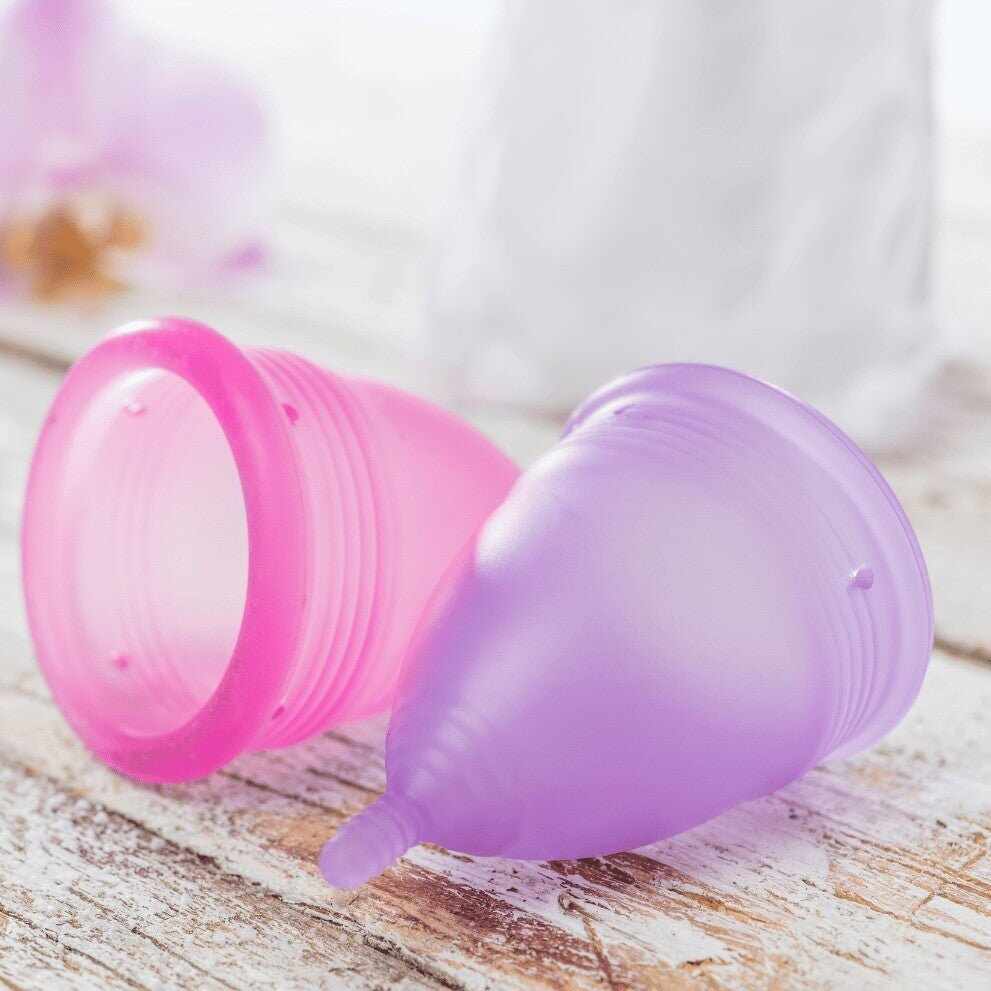The menstrual cup is an economical and ecological alternative to the classic tampons and sanitary towels that we normally use during the menstrual cycle.
Unlike other options, the menstrual cup collects the flow without absorbing it , and can be reused countless times: in fact, if used correctly, it can last up to 10 years with significant economic savings and greatly reducing the amount of waste produced!
The cup also helps you combat the feeling of vaginal dryness that can occur during your menstrual cycle. In fact, traditional pads not only absorb menstrual flow, but also cervical mucus, a powerful antibacterial and lubricant naturally produced by the vagina, which helps protect it from bacteria and foreign organisms.
Index
- How to use the menstrual cup
- How to fold the cup
- How to insert the menstrual cup
- How to remove your menstrual cup
- When to empty your menstrual cup
- How to clean your menstrual cup
- What are the opinions of gynecologists regarding the cup?
- What are the prices of menstrual cups?
- Can I use the cup if I have a retroverted uterus?
- Can I use the cup if I'm a virgin?
- How to use the cup for the first time?
- How to Clean a Cup in a Public Bathroom
- Where to store the cup?
- What to do if I just can't use the cup?
How to use the menstrual cup
The menstrual cup should be inserted , appropriately folded, into the vagina.Once inserted, it will open automatically , adhering to the walls and creating a sort of vacuum ; thanks to this there will be no blood leaks and it will be possible to lie down, play sports or swim without the risk of leaks.
The menstrual cup is therefore suitable for those who practice sports, even in water, or to better manage the cycle at the seaside .
To insert the cup, it is necessary to fold it so that it is not bulky and can be comfortably held with one hand. The cup should be emptied 2 to 4 times a day , depending on the abundance of the flow and the capacity of the cup chosen.
Once emptied, simply rinse it quickly with running water or clean it with a tissue before reinserting it. The cup should always be touched with clean hands and should be sterilized before its first use and between menstruations.
How to fold the cup
There are various folding techniques , the most practical are the "C", the "push down" and the "right angle" ones, but there are other variations that may be more suitable than others based on the softness of the cup and personal preferences.
- C-Fold : Squeeze the cup in half with two fingers and fold it in half, forming a small C.
- Push Down Fold : Starting from the open cup, push the edge inwards and join the ends
- Right-angle fold : Press the cup in half with two fingers and join one of the upper edges with the opposite lower edge.
How to insert the menstrual cup
The menstrual cup should be inserted inside the vagina. Once inside, the sensation is very similar to that of a tampon .
Fold the cup and hold it with your writing hand. Guide it toward your vaginal canal, using your other hand to open your labia minora for easier insertion.
Vaginal fluids should be enough to make insertion easier, but if you feel the need, you can use a water-based lubricant to make it easier .
For the first few times, it might be useful to try inserting it while squatting on the bidet to practice, but over time you will understand which position and technique are best suited to your body.
If you want to check that the cup is well inserted and open, just insert a finger into your vagina and follow the contour of the base of the cup: if you feel the lower part well rounded and open then it is positioned correctly.
If it feels a little closed, you can pull it lightly by the stem to help it sit better or you can simply remove it and reinsert it.
If you feel pain or discomfort, it means that the cup is not positioned correctly : sometimes just half a centimetre higher or lower is enough to completely change the sensation and find the perfect and comfortable position for you.
How to remove your menstrual cup
Once the cup is inserted, a suction effect is created that allows the flow to remain inside the cup without leaks. For this reason, the cup should never be removed by pulling , as this would only cause pain and risk damaging the capillaries in such a delicate and sensitive area. To remove the cup, grasp the base, squeezing lightly and making small zigzag movements so that small openings are created that allow air to enter, causing the cup to detach from the walls and be removed without pain.
Be careful during the exit phase which, especially during the first few times, can be slightly annoying.
When to empty your menstrual cup
To understand when to empty your cup , the only way is to learn to know your flow.
To do this, you just need to try the cup and change it every 3-4 hours at the beginning, to understand how full it is and if it needs to be emptied. Disposable pads have accustomed us to perceive our menstrual flow as more abundant than it actually is: a few drops of blood expand rapidly giving us the perception of a full pad that needs changing.
With the cup you will have the real perception of your flow and also the duration of your menstruation will be shorter: the vagina is a closed and narrow channel and the last losses go down slowly prolonging the duration of your menstruation. The cup, keeping the channel open, facilitates the flow exit reducing the duration of your menstruation.
In any case, remember to empty the cup at least once every 8 hours .
How to clean your menstrual cup
Before using it for the first time and between menstrual cycles, the cup should be disinfected to eliminate any bacteria that could cause infections. Under normal conditions, i.e. in the absence of infections such as candida, it is sufficient to wash the cup with water and a delicate detergent between changes and boil it in water between cycles.
Boiling can be done in a saucepan for 5 minutes from boiling or in a special microwave-safe container, at maximum power, for 6-7 minutes.
In extreme cases, such as in the case of infection or if the cup has fallen into a bathroom, a more thorough disinfection can be done with a solution specifically designed for cleaning baby bottles and baby equipment. In this case, rinse the cup very well afterwards, as contact between the mucous membranes and detergents could cause irritation.
What are the opinions of gynecologists regarding the cup?
More and more gynecologists are in favor of using the menstrual cup: if emptied regularly, in fact, it reduces the risks associated with prolonged blood stagnation that can instead occur in the case of using internal tampons. Furthermore, the cup , being made with safe materials such as silicone, does not release substances that are dangerous for our body as instead happens in the case of using tampons and external absorbents: it has in fact been demonstrated that these, in contact with the vagina and mucous membranes, release the chemical substances that are used such as perfumes, optical brighteners and substances capable of improving their absorbency.
What are the prices of menstrual cups?
A good quality cup costs on average 20 euros. The initial investment is therefore higher than that of a pack of disposable pads but considering that a cup lasts from 5 to 10 years the savings will be evident after the first year of use!
Can I use a cup if I have a retroverted uterus?
Yes, there are no contraindications. With a very tilted uterus the perfect positioning of the cup probably takes more time to find but for most women the cups fit well.
If your uterus is retroverted, you may find it more comfortable to insert the cup at a slightly upward angle.
Can I use the cup if I'm a virgin?
Yes, the cup can be used even if you have never had sexual intercourse. Virginity is a concept related to sexual intercourse and using a cup will not make you lose it.
However, the use of the menstrual cup can - in some cases, alter the hymen: take this into account if you attribute a religious or cultural significance to its integrity.
How to use the cup for the first time?
First of all, make yourself comfortable and read the instructions and warnings carefully, every cup you find on our site has them and they are very detailed!
Practice and be patient , like anything new it may seem cumbersome at first but it's just a matter of practice.
Start wearing it on days of light flow so that you don't have fears and become familiar with it.
In the first few days of use with heavy flow, put on a cotton panty liner to protect yourself from any leaks if it is not positioned perfectly.
How to Clean a Cup in a Public Bathroom
It is rare that you will have to empty it in a public bathroom, but if you do, empty it, dry it with a clean tissue, and replace it.
If you have a water bottle with you then you can rinse it out too.
Avoid using wet wipes because they are soaked in substances that are not suitable for contact with the internal mucosa.
Where to store the cup?
The cups often come with their own cotton bag to store them between periods. In any case, never use plastic bags or airtight containers, as they can create mold. Use only natural, breathable fabrics.
What to do if I just can't use the cup?
The cup is not the only alternative to the classic disposable and polluting pads! You can try organic cotton pads that are thrown away in the organic waste, washable pads and panty liners and even menstrual panties!
All information provided here is purely informative and indicative and does not in any way replace medical advice which is always recommended.
During your period, do you also have the feeling of having swollen and heavy legs? In this article we reveal 6 natural remedies to relieve tired legs !
Continue following our advice in the body care section of our blog !
[ApSC sc_key=sc3148331291][/ApSC]








